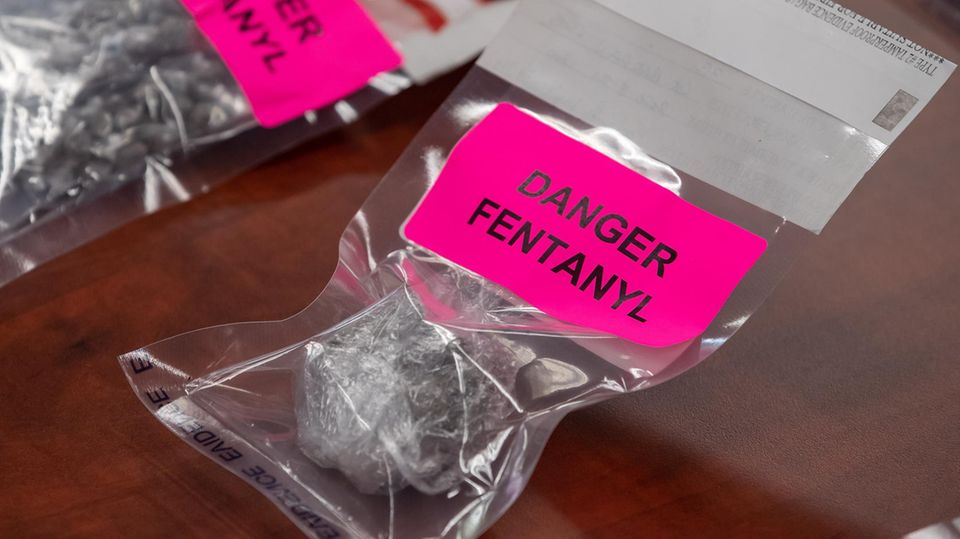Carfentanyl
5,000 times stronger than heroin – this is how the deadliest drug in the world works
There have already been deaths in Europe after taking carfentanyl (symbolic image)
© Panthermedia / Imago Images
Carfentanyl is a derivative of the opioid fentanyl, which kills tens of thousands of people in the United States each year. The new drug is extremely strong and dangerous. And it has now also arrived in Europe.
This article first appeared at NTV.de.
Elephants are anesthetized with the drug carfentanyl, and even the smallest amounts can be fatal to humans. The European drug monitoring agency EMCDDA reports dozens of deaths after taking carfentanyl, including in Belgium, Estonia, Norway, Sweden and Great Britain. Now the highly potent opioid is also appearing in Munich. Authorities are alarmed; they have long feared that fentanyl and its derivative carfentanyl are spreading more and more in Europe. But what makes narcotics so dangerous?
Fentanyl is a strong painkiller that is used, among other things, by cancer patients, but is also traded illegally. The synthetic opioid is 50 times more potent than heroin. With chemicals manufactured primarily in China, it is often produced in Mexico and from there to the USA, where it has long since triggered a crisis: every year tens of thousands of Americans die from an overdose of the synthetic drug. According to the U.S. government, fentanyl is the number one cause of death for people between the ages of 18 and 49 in the country.
Actually far too strong for humans
Carfentanyl is a chemical compound that is derived from fentanyl but is significantly more potent. According to experts, the substance is 100 times stronger than fentanyl, 5,000 times stronger than heroin and 10,000 times stronger than morphine. Therefore, the drug is not used in medicine on people, but is used to anesthetize large wild animals such as lions, elks or polar bears.

Depending on the dose, the opioids have a pain-relieving, calming or even euphoric effect – and quickly become addictive. With regular consumption, the body gets used to the substances and develops a tolerance. As a result, increasingly higher doses are required for the preparations to work. The risk of an overdose increases. The consequences are impaired consciousness, slowed breathing and constricted pupils. In the worst case, breathing stops completely and life-threatening respiratory paralysis occurs.
According to the US Drug Enforcement Agency (DEA), just two milligrams of fentanyl – the amount that fits on the tip of a pencil – is considered potentially fatal. With carfentanyl, an amount the size of a grain of sand is enough. In the latter case, just a few nanograms have an intoxicating effect. This makes carfentanyl even more unpredictable than its predecessor and at the same time even more attractive for the black market.
Because production is comparatively cheap, heroin is increasingly being mixed with fentanyl and, more recently, with carfentanyl. A highly dangerous mixture. Many addicts do not know what they are consuming and cannot assess the effects of the drugs. Tiny amounts have an enormous effect and are therefore difficult to control, says Oliver Pogarell, deputy director of the Munich University Hospital, to the “Bild” newspaper. “In a single unit of heroin, for example half a gram, even a single grain of carfentanyl can be fatal.”
In the current case in Munich, it is also likely that the drug user being controlled was clueless. Officials confiscated a bag of powder from the 54-year-old. It later turned out that it also contained carfentanyl. “It could be that the man didn’t even know what else was mixed into his heroin,” said an LKA spokesman. This is what makes carfentanyl so dangerous.
Carfentanyl is still not very widespread in Germany
So far, the events in Munich are an isolated case and both carfentanyl and fentanyl are a marginal phenomenon in Germany. However, addiction experts fear that this could change. “The fact is that fentanyl is already in Europe, is extremely potent and must be treated as an imminent threat,” warned Interpol Secretary General Jürgen Stock in “Welt am Sonntag”.
Nevertheless: “An opioid crisis like in the USA and Canada will not repeat itself here,” said the federal government’s drug commissioner, Burkhard Blienert, to the newspaper. “We fundamentally have different, better conditions.” The starting point of the fentanyl crisis in the USA was an excessive prescription of strong painkillers; in Germany people are much more cautious.
“Nevertheless, it would also be possible for us that heroin users would increasingly switch to cheaper and much more dangerous fentanyl,” said Blienert. More low-threshold offers for consumers are needed. “These include drug checking, rapid tests in drug consumption rooms and also the use of the emergency medication naloxone, which even medical laypeople can administer,” said the drug commissioner.
Read at stern+: Our reporter knows Latin America and its drug cartels well. He lived in a favela for several years. After researching the opioid crisis in the USA, he discovered that the actual drug lords are somewhere else entirely.



